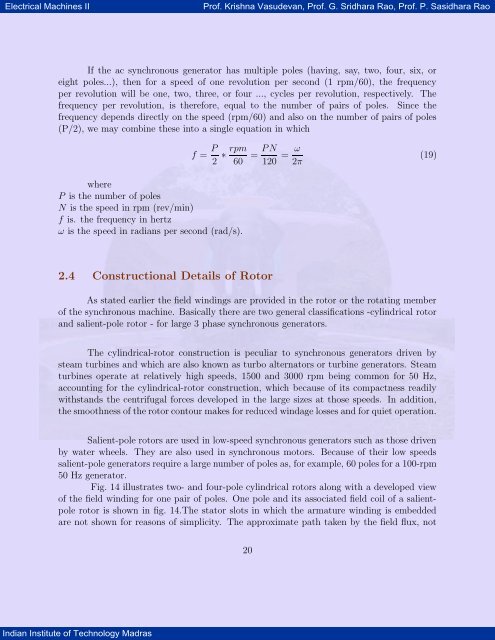Synchronous Machines - E-Courses
Synchronous Machines - E-Courses
Synchronous Machines - E-Courses
You also want an ePaper? Increase the reach of your titles
YUMPU automatically turns print PDFs into web optimized ePapers that Google loves.
Electrical <strong>Machines</strong> II Prof. Krishna Vasudevan, Prof. G. Sridhara Rao, Prof. P. Sasidhara Rao<br />
If the ac synchronous generator has multiple poles (having, say, two, four, six, or<br />
eight poles...), then for a speed of one revolution per second (1 rpm/60), the frequency<br />
per revolution will be one, two, three, or four ..., cycles per revolution, respectively. The<br />
frequency per revolution, is therefore, equal to the number of pairs of poles. Since the<br />
frequency depends directly on the speed (rpm/60) and also on the number of pairs of poles<br />
(P/2), we may combine these into a single equation in which<br />
Indian Institute of Technology Madras<br />
f = P<br />
2<br />
∗ rpm<br />
60<br />
where<br />
P is the number of poles<br />
N is the speed in rpm (rev/min)<br />
f is. the frequency in hertz<br />
ω is the speed in radians per second (rad/s).<br />
= P N<br />
120<br />
2.4 Constructional Details of Rotor<br />
= ω<br />
2π<br />
As stated earlier the field windings are provided in the rotor or the rotating member<br />
of the synchronous machine. Basically there are two general classifications -cylindrical rotor<br />
and salient-pole rotor - for large 3 phase synchronous generators.<br />
The cylindrical-rotor construction is peculiar to synchronous generators driven by<br />
steam turbines and which are also known as turbo alternators or turbine generators. Steam<br />
turbines operate at relatively high speeds, 1500 and 3000 rpm being common for 50 Hz,<br />
accounting for the cylindrical-rotor construction, which because of its compactness readily<br />
withstands the centrifugal forces developed in the large sizes at those speeds. In addition,<br />
the smoothness of the rotor contour makes for reduced windage losses and for quiet operation.<br />
Salient-pole rotors are used in low-speed synchronous generators such as those driven<br />
by water wheels. They are also used in synchronous motors. Because of their low speeds<br />
salient-pole generators require a large number of poles as, for example, 60 poles for a 100-rpm<br />
50 Hz generator.<br />
Fig. 14 illustrates two- and four-pole cylindrical rotors along with a developed view<br />
of the field winding for one pair of poles. One pole and its associated field coil of a salientpole<br />
rotor is shown in fig. 14.The stator slots in which the armature winding is embedded<br />
are not shown for reasons of simplicity. The approximate path taken by the field flux, not<br />
20<br />
(19)

















